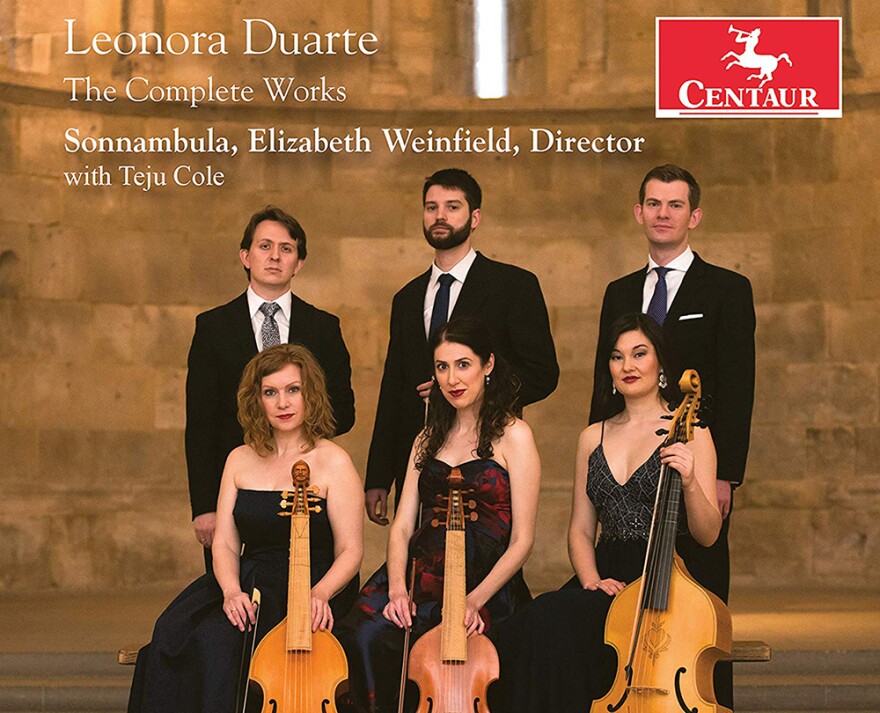September 30, 2019. Our guest author this week is Elizabeth Weinfield, a viol player, Juilliard musicologist, and the artistic director of Sonnambula, a historically informed Early Music ensemble based in NYC. Sonnambula’s latest release is Leonora Duarte: The Complete Works.My first exposure to the music of Baroque composer Leonora Duarte (1610–1678) came while sight-reading with friends years ago on a frosty night in England. The details of the evening are etched in my mind (as are details of all of one's formative experiences): the crackling of the fireplace as we explored the sinuous lines of melody, and the excitement of knowing that I was likely one of the few people in the world hearing Duarte's voice since it had been conscribed to music parchment nearly 400 years before.
Duarte was a Jewish converso, a term applied in Portugal and Spain to ancestors of baptized Jews suspected of secretly observing Judaism. She was born in 1610 in Antwerp to a prominent family of merchants and art collectors, originally from Portugal who socialized with the keyboard-making Ruckers family, William and Margaret Cavendish, and possibly the artist Peter Paul Rubens.
She composed seven short pieces—sinfonias—during her lifetime; today they are the only record we have of music written for the viol by a woman in the 17th century. And not only are they rare, but much to the good fortune of the performer, the works also betray a formidable talent for composition, a fierce personality, and a sense of quietude and introspection.
Sonnambula recently recorded Duarte's complete oeuvre, a recording that presents a rare opportunity for audiences to hear this music in its entirety (Centaur, 2019).
Duarte received a superb musical education that included instruction on viol, virginals, and lute, as well as lessons in composition. Her musical evenings at home with her siblings quickly made her home a well-known port-of-call for traveling diplomats and literati, among them the poet and diplomat Constantijn Huygens, the Dutch poet Anna Roemers Visscher, the composer Nicholas Lanier, and the singer Anne de la Barre.
Yet both ethnically Jewish and a woman, Duarte received no commissions from either church or court. The sinfonias, then — and the good fortune of their existence — present us with a remarkable opportunity to consider Baroque music making within the domestic sphere, where it would have originally been heard and performed.
Who was this woman whose music-making was compared to that of Monteverdi? Who was this Belgian with a Portuguese name, this Catholic daughter of a man given a Mass at his death, this epistolary companion of Margaret Cavendish — this Jewess? We cannot ever know.
But what we do know is that she existed within a rich nexus of diverse influences amidst the complicated world of 17th-century Antwerp — a city that had banned the practice of Judaism and in which Judeo-Portuguese immigrants like Duarte and her family were forced to live as converted Christians, and in a time in which a deeply engrained culture of anti-Semitism positioned conversion, identity blending, and “passing” as de rigueur.
These complexities resonate with my own, at times tangled, identity as a somewhat secular New Yorker with Jewish roots, replete with identity baggage that silently informs everything about my musicianship, from choosing repertoire to the way that I perform it.
The only record we have of music written for the viol by a woman in the 17th century.
Duarte’s music inevitably stands as exceptional and vital testimony to the cultural accomplishments of women conversos in early modern Europe, a subject about which almost nothing is known. Musically speaking, the work is also evidence of a complex and symbiotic relationship that Duarte had with her male contemporaries. Some of these composers also appear on the recording for context: among them are the Elizabethan John Bull (1562/3–1628), who was director of music at Antwerp cathedral and very likely her composition tutor; Alfonso Ferrabosco II (c. 1575–1628); and John Jenkins (1592–1678).
Cole's work in the history of Antwerp deals with memory, the mapping of urban environments, and in connecting space and time via observation. His collaboration on this project as historian and photographer is the inevitable result of years of walking together through museums. His work anchors our dialogue with what we have found to be a multitude of convergent pasts.
I hope that hearing the music performed live in the intimate setting of the WRTI 90.1 studio, on October 10th at 12:10 PM, will also prompt us to consider the work as a product of Duarte's interactions with a vibrant urban community of artists, musicians, and thinkers—and as vital testimony to the cultural accomplishments of women conversos in early modern Europe (and about which, very little is known).
Listeners will also have the opportunity to hear a spoken essay written especially for this recording by award-winning writer Teju Cole, Gore Vidal Professor of the Practice of Creative Writing at Harvard.

